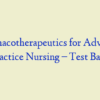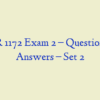Description
NUR 2063 Essentials of Pathophysiology Exam #1 Study Guide
Covers Modules 1, 2, and 3
Chapters 1, 2, 3, 7, 8, 9, 10, 24, 51, 52, 53
- Define pathophysiology. What does the study of pathophysiology include?
- Review terms such as signs, symptoms, acute, chronic, exacerbation, remission, convalescence, and sequela
- What is epidemiology? Review the different levels of disease prevention such as primary, secondary, and tertiary as well as examples for each.
- Review the difference between homeostasis and allostasis.
- Review the three different stages of the General Adaptation Syndrome (GAS) including the alarm stage, adaptation/resistance, and exhaustion stage. What hormones are released during the alarm stage and what effects do they have on the body?
- Review the differences between the sympathetic vs the parasympathetic nervous systems. What happens to the body during “fight-or-flight” response?
- Review the functions of the various organelles of the cell such as the nucleus, mitochondria, ribosome, lysosome, endoplasmic reticulum, peroxisome, golgi apparatus
- Review the differences between extracellular fluid and intracellular fluid. Which electrolytes are found in high concentration outside the cell versus inside the cell?
- Review how fluid is transported across the plasma membrane of the cell. What forces drive the movement of water across the membrane?
- Review ways that fluids enter the human body (intake) versus ways fluid is excreted (output) out of the body.
- Review conditions that result in ECF volume deficit (dehydration) versus ECF volume excess (hypotonic hydration). What are signs, symptoms, and causes for each?
- What is edema? Review the various factors that can contribute to edema.
- Why are electrolytes important?
- What hormones play a role in regulating electrolyte levels?
- What are electrolyte reservoirs? What electrolytes are found stored in bones?
- What are the cardinal signs and symptoms of inflammation? What lab tests can detect inflammation in the body?
- Review the role of histamines, prostaglandins, and leukotrienes. What effect do they have on the body during an immune response?
- Review the differences between innate and adaptive immunity, which is specific? Which is nonspecific?
- Review the following terms: virulence, invasion, exotoxin, endotoxin, and antimicrobial resistance. What factors contribute to antimicrobial resistance in microorganisms? How can we prevent the spread of microorganisms?
- Review the difference between active and passive immunity, know examples for each type.
- What is hypersensitivity? Review the four different types of hypersensitivities: Type I (Anaphylactic), Type II (Cytotoxic), Type III (Immune complex), Type IV (Delayed cell-mediated). Know examples and mediating factors for each type.
- Review the differences between benign and malignant tumors.
- What are the three steps of carcinogenesis?
- Review the effects of cancer on the body including terms: cachexia, anemia, leukopenia, and thrombocytopenia.
- Review the various infections of the skin discussed in class including warts, herpes simplex virus, herpes zoster, fungal infections, impetigo, and leprosy.
- Review the various inflammatory conditions of the skin discussed in class including lupus, psoriasis, atopic and contact dermatitis.
- Review parasitic infections of the skin/hair including lice, scabies, ticks, and bedbugs.
- What are pressure ulcers? How are they staged and how can we prevent them?
- What is compartment syndrome? Why does it occur and what are the signs? Remember the 5 P’s
- Review diseases of the bone including osteomyelitis, osteosarcoma, osteomalacia, and osteoporosis
- Review disorders of the muscle including myasthenia gravis, fibromyalgia, and muscular dystrophy. Know the causes and signs/symptoms for each.
- Review disorders of the joints including rheumatoid arthritis, osteoarthritis, psoriatic arthritis, and gout. Know the causes and signs/symptoms for each.




